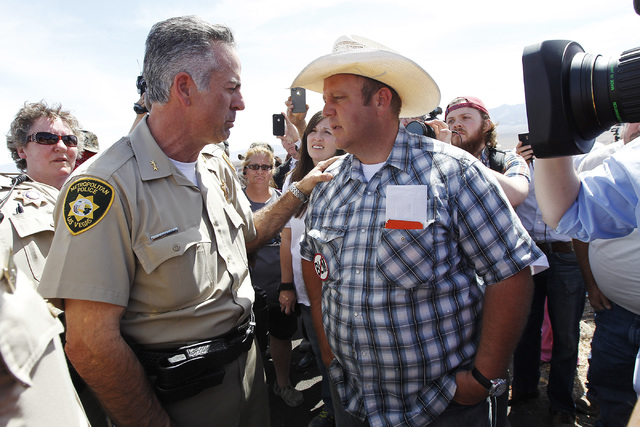BLM chief: Lawbreakers in Bundy confrontation will be held accountable

WASHINGTON — The director of the Bureau of Land Management said Monday that lawbreakers will be “held accountable” as the agency pursues a new plan to enforce court orders against Southern Nevada rancher Cliven Bundy for illegally grazing cattle on public land.
Agency head Neil Kornze said the BLM now plans to act through the courts after its attempt to round up trespassing cattle was scuttled last month by the threat of violence
“Some folks did break the law,” Kornze said. “We are working hard to ensure that those who did break the law are held accountable.”
Kornze’s comments on National Public Radio were his first since directing BLM wranglers and armed agents on April 12 to suspend the operation to seize Bundy cattle in the Gold Butte area of Clark County. They were consistent with written statements the BLM has issued since the confrontation that day with Bundy and armed supporters.
Now, Kornze said, “we are going to work through the legal system.” He said his comments had to be limited because an investigation is underway. Clark County Sheriff Doug Gillespie confirmed last week the FBI has opened a criminal probe of alleged threats and assaults on law enforcement officers at the roundup.
Kornze spoke carefully when asked about Bundy during a short discussion on the network’s “Diane Rehm Show.” He said the Nevadan’s case was an isolated one.
“The context is important,” Kornze said. “We have 16,000 ranchers across the country that work with the Bureau of Land Management and have permits to graze on the public land.” Bundy has been engaged in a 20-year permit dispute that culminated in court orders for his cows to be removed from the range.
The rancher says the BLM has been trying to take away his livelihood, and he does not recognize federal government jurisdiction on the land. Armed supporters congregated at Bundy’s ranch on the eve of the roundup, and some remain. Meanwhile, protests over federal land control spread to neighboring Utah over the weekend, when nearly 50 people demonstrated against the government by riding off-road vehicles on an off-limits trail.
On another topic, Kornze said the BLM was working closely with Western states in advance of decisions by the U.S. Fish and Wildlife Service whether to list the sage grouse, a chicken-sized range bird, as a threatened or endangered species.
Such a listing would lock up millions of acres, prompting fears that mining, ranching and energy exploration could be declared off-limits.
Kornze said there are instances where activities are allowed to take place alongside endangered species on public lands, with Fish and Wildlife Services playing a large role in determining what is permissible.
“It is possible to continue working even if there is a designation, but it will have an impact and it will make things more complicated,” Kornze said.
In central California, grazing is allowed on certain allotments that provide habitat for the endangered giant kangaroo rat, San Joaquin kit fox, the blunt-nosed leopard lizard and the San Joaquin wooly-threads, a rare flowering plant, according to the BLM. In southwestern Oregon, streams home to the threatened coho salmon are managed for multiple uses, the BLM said.
Contact Stephens Washington Bureau chief Steve Tetreault at 202-783-1760 or STetreault@stephensmedia.com Follow @STetreaultDC on Twitter